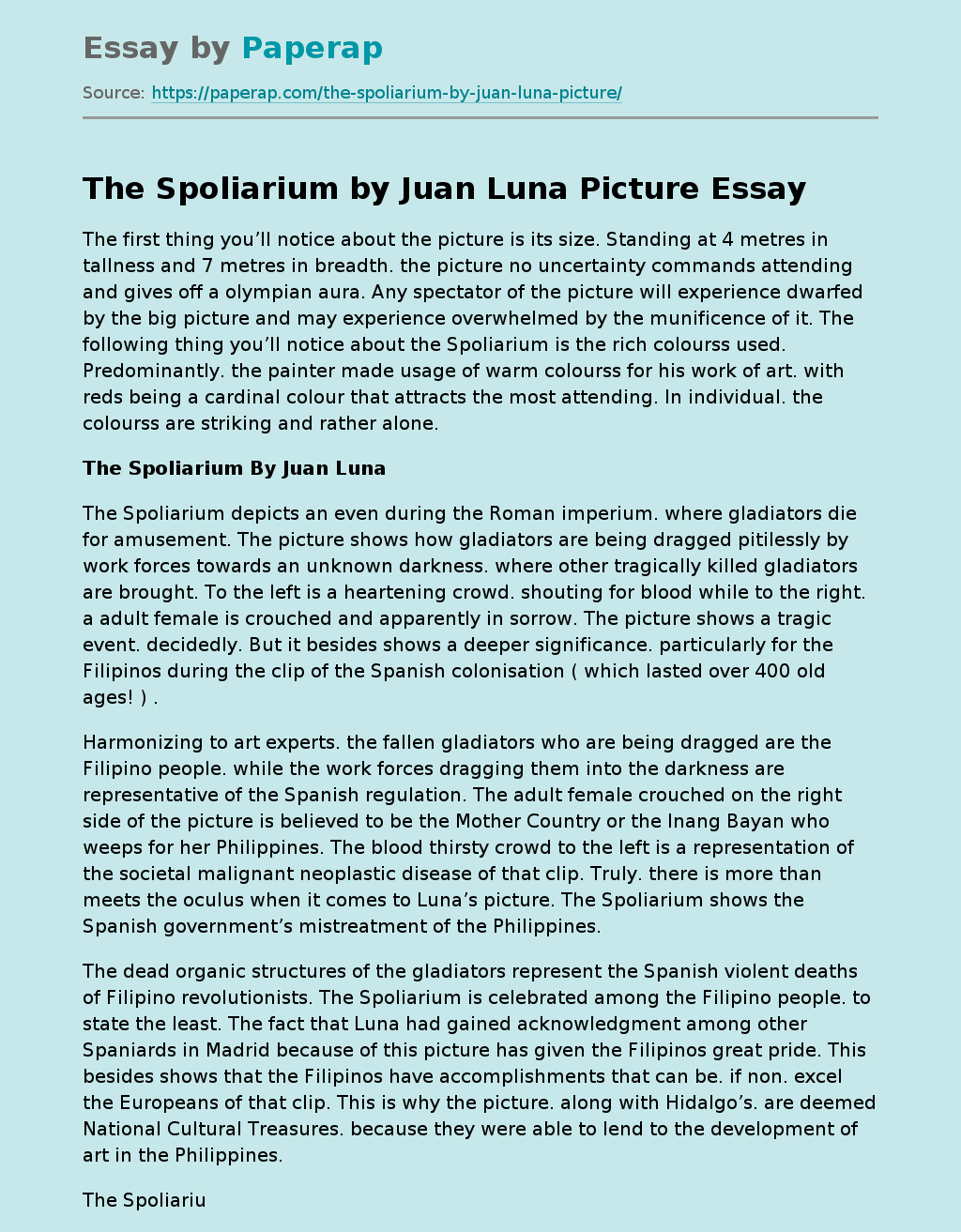The Spoliarium by Juan Luna Picture
The first thing you’ll notice about the picture is its size. Standing at 4 metres in tallness and 7 metres in breadth. the picture no uncertainty commands attending and gives off a olympian aura. Any spectator of the picture will experience dwarfed by the big picture and may experience overwhelmed by the munificence of it. The following thing you’ll notice about the Spoliarium is the rich colourss used. Predominantly. the painter made usage of warm colourss for his work of art.
with reds being a cardinal colour that attracts the most attending. In individual. the colourss are striking and rather alone.
The Spoliarium By Juan Luna
The Spoliarium depicts an even during the Roman imperium. where gladiators die for amusement. The picture shows how gladiators are being dragged pitilessly by work forces towards an unknown darkness. where other tragically killed gladiators are brought. To the left is a heartening crowd. shouting for blood while to the right. a adult female is crouched and apparently in sorrow.
The picture shows a tragic event. decidedly. But it besides shows a deeper significance. particularly for the Filipinos during the clip of the Spanish colonisation ( which lasted over 400 old ages! ) .
Harmonizing to art experts. the fallen gladiators who are being dragged are the Filipino people. while the work forces dragging them into the darkness are representative of the Spanish regulation. The adult female crouched on the right side of the picture is believed to be the Mother Country or the Inang Bayan who weeps for her Philippines.
The blood thirsty crowd to the left is a representation of the societal malignant neoplastic disease of that clip. Truly. there is more than meets the oculus when it comes to Luna’s picture. The Spoliarium shows the Spanish government’s mistreatment of the Philippines.
The dead organic structures of the gladiators represent the Spanish violent deaths of Filipino revolutionists. The Spoliarium is celebrated among the Filipino people. to state the least. The fact that Luna had gained acknowledgment among other Spaniards in Madrid because of this picture has given the Filipinos great pride. This besides shows that the Filipinos have accomplishments that can be. if non. excel the Europeans of that clip. This is why the picture. along with Hidalgo’s. are deemed National Cultural Treasures. because they were able to lend to the development of art in the Philippines.
The Spoliarium can be found in the Hall of the Masters of The National Museum of the Philippines. Whether you are a alien or a local. take a few hours off your agenda to see the museum and larn more about Filipino civilization and history through the eyes of its creative persons. It is an educational and enriching experience. The first thing you’ll notice about the picture is its size. Standing at 4 metres in tallness and 7 metres in breadth. the picture no uncertainty commands attending and gives off a olympian aura.
Any spectator of the picture will experience dwarfed by the big picture and may experience overwhelmed by the munificence of it. The following thing you’ll notice about the Spoliarium is the rich colourss used. Predominantly. the painter made usage of warm colourss for his work of art. with reds being a cardinal colour that attracts the most attending. In individual. the colourss are striking and rather alone. The Spoliarium depicts an even during the Roman imperium. where gladiators die for amusement. The picture shows how gladiators are being dragged pitilessly by work forces towards an unknown darkness. where other tragically killed gladiators are brought.
To the left is a heartening crowd. shouting for blood while to the right. a adult female is crouched and apparently in sorrow. The picture shows a tragic event. decidedly. But it besides shows a deeper significance. particularly for the Filipinos during the clip of the Spanish colonisation ( which lasted over 400 old ages! ) . Harmonizing to art experts. the fallen gladiators who are being dragged are the Filipino people. while the work forces dragging them into the darkness are representative of the Spanish regulation. The adult female crouched on the right side of the picture is believed to be the Mother Country or the Inang Bayan who weeps for her Philippines.
The blood thirsty crowd to the left is a representation of the societal malignant neoplastic disease of that clip. Truly. there is more than meets the oculus when it comes to Luna’s picture. The Spoliarium shows the Spanish government’s mistreatment of the Philippines. The dead organic structures of the gladiators represent the Spanish violent deaths of Filipino revolutionists. The Spoliarium is celebrated among the Filipino people. to state the least. The fact that Luna had gained acknowledgment among other Spaniards in Madrid because of this picture has given the Filipinos great pride.
This besides shows that the Filipinos have accomplishments that can be. if non. excel the Europeans of that clip. This is why the picture. along with Hidalgo’s. are deemed National Cultural Treasures. because they were able to lend to the development of art in the Philippines. The Spoliarium can be found in the Hall of the Masters of The National Museum of the Philippines. Whether you are a alien or a local. take a few hours off your agenda to see the museum and larn more about Filipino civilization and history through the eyes of its creative persons. It is an educational and enriching experience.
The Spoliarium by Juan Luna Picture. (2019, Dec 05). Retrieved from https://paperap.com/the-spoliarium-by-juan-luna-picture/

